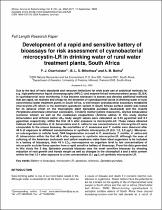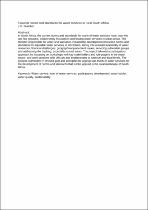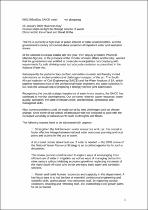 ResearchSpace
ResearchSpace
Development of a rapid and sensitive battery of bioassays for risk assessment of cyanobacterial microcystin-LR in drinking water of rural water treatment plants, South Africa
JavaScript is disabled for your browser. Some features of this site may not work without it.
- ResearchSpace
- →
- Research Publications/Outputs
- →
- Journal Articles
- →
- View Item
| dc.contributor.author |
Oberholster, Paul J

|
|
| dc.contributor.author |
Mthethwa, BLS

|
|
| dc.contributor.author |
Botha, AM

|
|
| dc.date.accessioned | 2010-01-11T13:12:33Z | |
| dc.date.available | 2010-01-11T13:12:33Z | |
| dc.date.issued | 2009-09 | |
| dc.identifier.citation | Oberholster, P.J., Mthethwa, B.L.S. and Botha, A.M. 2009. Development of a rapid and sensitive battery of bioassays for risk assessment of cyanobacterial microcystin-LR in drinking water of rural water treatment plants, South Africa. African Journal of Biotechnology, Vol.8(18), pp 4562-4571 | en |
| dc.identifier.issn | 1684-5315 | |
| dc.identifier.uri | http://hdl.handle.net/10204/3873 | |
| dc.description | Creative Commons Attribution License | en |
| dc.description.abstract | Due to the lack of toxin standards and resource limitations for wide scale use of analytical methods for e.g. high-performance liquid chromatography (HPLC) and enzyme-linked immunosorbent assay (ELISA) in cyanobacterial toxin monitoring, it has become necessary to assess and develop additional methods that are rapid, yet realistic and cheap for the detection of cyanobacterial toxins in drinking water of rural conventional water treatment plants in South Africa. A well-known cyanobacterial secondary metabolite (microcystin-LR) which is the dominant cyanotoxin variant in South African surface waters was tested for its adverse effect on the macrophyte plant Spirodela punctata (duckweed) and the insects Periplaneta americana (American cockroach), Tenebrio molitar (yellow mealworm), Gryllus bimaculatus (common cricket) as well as the crustacean zooplankton (Artemia salina). In this study Gryllus bimaculatus and Artemia salina LD50 body weight values were calculated as 0.45 µg/animal and 0.1 µg/animal, respectively, within the first 48 h after exposure to microcystin-LR. These values obtained indicate that sensitivities of G. bimaculatus and A. salina to low concentrations of microcystin-LR were comparable to the mouse bioassay. No mortalities of P. americana and T. molitar were observed after 48 h of exposure to different concentrations of synthetic microcystin-LR (0.5, 1.0, 5.0 µg/L). Moreover, on sub-organism or cellular level, DNA fragmentation occured in P. americana, T. molitar, A. salina and G. bimaculatus within the first 48 h after exposure to synthetic microcystin-LR. Although the ease of culturing of the American cockroach and yellow mealworm make them ideal organisms to be included in a battery of bioassays, their 48 h LD50 non-response on organism level to low concentrations of microcystin exclude these species from a rapid sensitive battery of bioassays. From the data generated in this study the 5 day Spirodela punctata bioassay was the most sensitive bioassay by showing reduction of root growth and fronds weight as well as changes in the chlorophyll a and b ratio content within the first 12 h after exposure to a low concentration (0.1 µg/L) of synthetic microcystin-LR. | en |
| dc.language.iso | en | en |
| dc.publisher | Academic Journals | en |
| dc.subject | Bioassays | en |
| dc.subject | Cyanobacterial microcystin-LR | en |
| dc.subject | Apoptosis | en |
| dc.subject | Chlorosis | en |
| dc.subject | Spirodela punctata | en |
| dc.subject | Rural water treatment plants | en |
| dc.subject | Drinking water | en |
| dc.subject | Rural water | en |
| dc.subject | Water treatment | en |
| dc.title | Development of a rapid and sensitive battery of bioassays for risk assessment of cyanobacterial microcystin-LR in drinking water of rural water treatment plants, South Africa | en |
| dc.type | Article | en |
| dc.identifier.apacitation | Oberholster, P. J., Mthethwa, B., & Botha, A. (2009). Development of a rapid and sensitive battery of bioassays for risk assessment of cyanobacterial microcystin-LR in drinking water of rural water treatment plants, South Africa. http://hdl.handle.net/10204/3873 | en_ZA |
| dc.identifier.chicagocitation | Oberholster, Paul J, BLS Mthethwa, and AM Botha "Development of a rapid and sensitive battery of bioassays for risk assessment of cyanobacterial microcystin-LR in drinking water of rural water treatment plants, South Africa." (2009) http://hdl.handle.net/10204/3873 | en_ZA |
| dc.identifier.vancouvercitation | Oberholster PJ, Mthethwa B, Botha A. Development of a rapid and sensitive battery of bioassays for risk assessment of cyanobacterial microcystin-LR in drinking water of rural water treatment plants, South Africa. 2009; http://hdl.handle.net/10204/3873. | en_ZA |
| dc.identifier.ris | TY - Article AU - Oberholster, Paul J AU - Mthethwa, BLS AU - Botha, AM AB - Due to the lack of toxin standards and resource limitations for wide scale use of analytical methods for e.g. high-performance liquid chromatography (HPLC) and enzyme-linked immunosorbent assay (ELISA) in cyanobacterial toxin monitoring, it has become necessary to assess and develop additional methods that are rapid, yet realistic and cheap for the detection of cyanobacterial toxins in drinking water of rural conventional water treatment plants in South Africa. A well-known cyanobacterial secondary metabolite (microcystin-LR) which is the dominant cyanotoxin variant in South African surface waters was tested for its adverse effect on the macrophyte plant Spirodela punctata (duckweed) and the insects Periplaneta americana (American cockroach), Tenebrio molitar (yellow mealworm), Gryllus bimaculatus (common cricket) as well as the crustacean zooplankton (Artemia salina). In this study Gryllus bimaculatus and Artemia salina LD50 body weight values were calculated as 0.45 µg/animal and 0.1 µg/animal, respectively, within the first 48 h after exposure to microcystin-LR. These values obtained indicate that sensitivities of G. bimaculatus and A. salina to low concentrations of microcystin-LR were comparable to the mouse bioassay. No mortalities of P. americana and T. molitar were observed after 48 h of exposure to different concentrations of synthetic microcystin-LR (0.5, 1.0, 5.0 µg/L). Moreover, on sub-organism or cellular level, DNA fragmentation occured in P. americana, T. molitar, A. salina and G. bimaculatus within the first 48 h after exposure to synthetic microcystin-LR. Although the ease of culturing of the American cockroach and yellow mealworm make them ideal organisms to be included in a battery of bioassays, their 48 h LD50 non-response on organism level to low concentrations of microcystin exclude these species from a rapid sensitive battery of bioassays. From the data generated in this study the 5 day Spirodela punctata bioassay was the most sensitive bioassay by showing reduction of root growth and fronds weight as well as changes in the chlorophyll a and b ratio content within the first 12 h after exposure to a low concentration (0.1 µg/L) of synthetic microcystin-LR. DA - 2009-09 DB - ResearchSpace DP - CSIR KW - Bioassays KW - Cyanobacterial microcystin-LR KW - Apoptosis KW - Chlorosis KW - Spirodela punctata KW - Rural water treatment plants KW - Drinking water KW - Rural water KW - Water treatment LK - https://researchspace.csir.co.za PY - 2009 SM - 1684-5315 T1 - Development of a rapid and sensitive battery of bioassays for risk assessment of cyanobacterial microcystin-LR in drinking water of rural water treatment plants, South Africa TI - Development of a rapid and sensitive battery of bioassays for risk assessment of cyanobacterial microcystin-LR in drinking water of rural water treatment plants, South Africa UR - http://hdl.handle.net/10204/3873 ER - | en_ZA |








